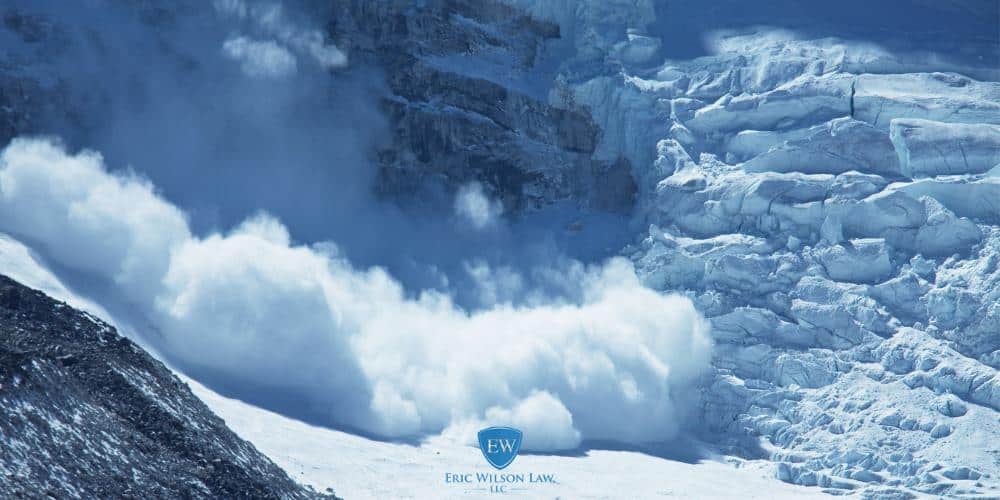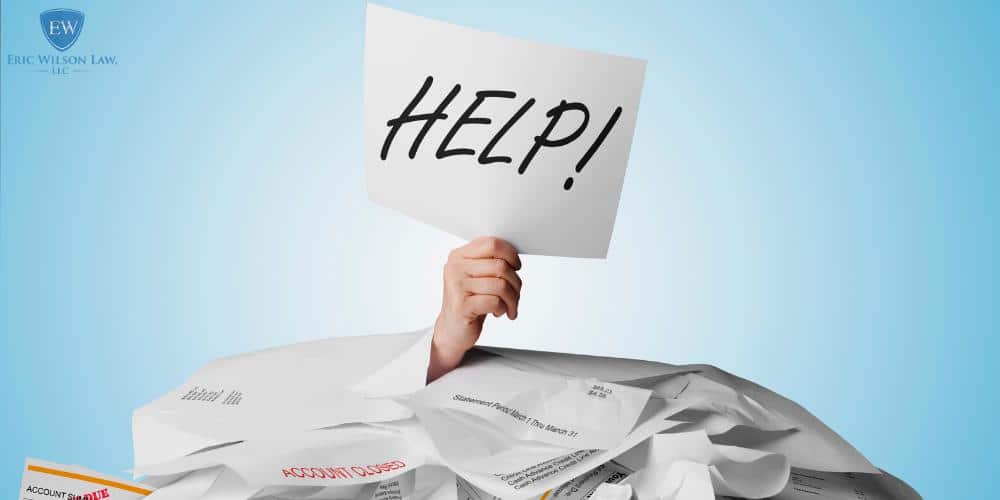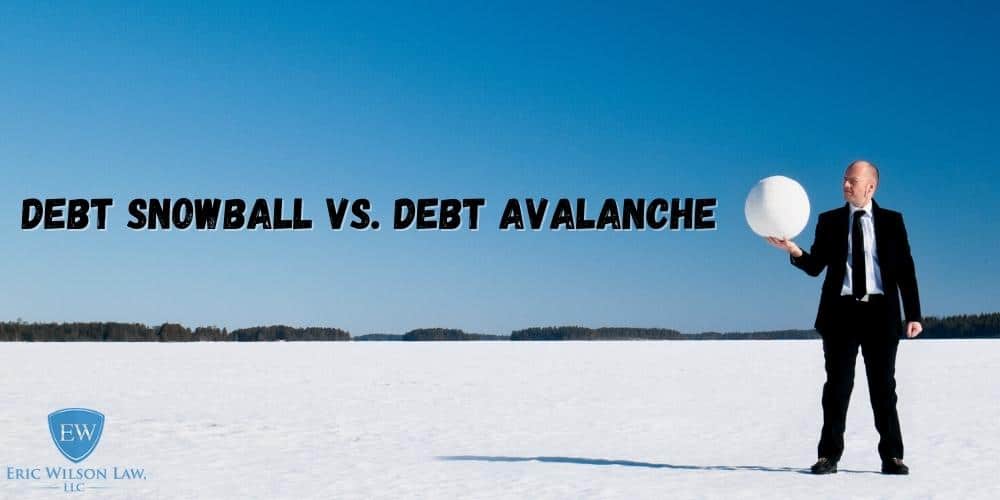Two of the most common debt repayment methods out there are the debt snowball vs. debt avalanche methods. Both methods work by speeding up the debt repayment process. But one method prioritizes the smallest balance first, while the other method prioritizes debt with the highest interest rate first. The goal is to stick with either method until you are debt free.
Below, Eric Wilson breaks down the pros and cons of the debt snowball vs. debt avalanche methods. Additionally, he explains which debt relief method may be best for you and your financial situation. For more information on how Eric Wilson can help you achieve a debt free life, call 205-349-1280 today. He offers a free consultation to all new clients.
What is the Debt Snowball Method?
The debt snowball method is one of many types of debt relief methods out there. So – how does the debt snowball method work? First, make a list of all your debts from smallest to largest. Then pick the smallest debt you have and pay it in full while making minimum payments on the rest of your debts. If you can’t completely pay off the smallest balance, just put as much money into it as you can. Then move onto your second smallest debt and do the same thing. Keep working up your list of debts, paying them off from smallest to largest. Once you pay off one or more of your smaller debts, use the extra money you would have put towards those debts and instead put it toward your larger debts.
You can use this debt repayment strategy for many types of debts like car loans, student loans, medical bills, personal loans, and credit card debt. You should not use this method to pay off a mortgage, though.
Pros
- The debt snowball method is great in that it helps you stay motivated to pay off debt little by little. When you pay off the smallest debts, you feel accomplished and excited to continue paying off the larger balances until you are debt free.
- This debt repayment method is easy to start. Most people don’t feel incredibly overwhelmed by the prospect of paying off small outstanding debts first.
Cons
- The debt snowball method can be expensive in that you can incur more interest payments on your other debts over the course of several months or years.
- The debt snowball method is probably the epitome of: “slow and steady wins the race.” You can eventually become debt free using this method, but it may take a long time, especially depending on how much debt you have.

What is the Debt Avalanche Method?
The debt avalanche method is another common debt repayment strategy that people may use to gain financial relief from a student loan, a car loan, credit card balances, and medical bills. This is how it works: you pay the minimum payment on all of your debts. Any leftover money you have will go towards the debt with the highest interest rate. Once you pay off the higher interest debt, you will use the money you would have put towards this debt and put it towards your other debts with high interest rates.
The debt avalanche method is kind of the exact opposite of the debt snowball method in that you prioritize paying the largest debt with the highest interest rates first. For many people, this means focusing on a credit card balance first, because that is usually the highest interest debt.
Pros
- You can save money in the long run by paying off a debt with a high interest rate first.
- You can also save time by prioritizing paying debt with the highest interest rate first. High interest rates almost always equal more time.
- The debt avalanche method is great for disciplined, motivated, and budget-oriented people.
Cons
- If you struggle with self-discipline and/or commitment, the debt avalanche method may not work for you. If you take one or two months off of this method, you may not get very far with paying off your debt.
- This debt relief method may be incredibly overwhelming at first, because you’re essentially focusing on paying off the biggest debt with the highest interest rate first.
- If you don’t have a decent amount of disposable income on a monthly basis, you may not be able to do this debt repayment plan.
Should I Choose the Debt Snowball or the Debt Avalanche Method?
Choosing between debt snowball vs. debt avalanche depends on several factors, like how much debt you have, how many of your debts have high interest rates, and your personality type.
If you have so much debt to the point where your debt to income ratio (DTI) is above 35%, your credit utilization ratio is above 30%, and you feel like you can’t afford your daily necessities, you may want to consider the debt avalanche method. If you have a manageable amount of debt – and only a few of your debts have high interest rates, the debt snowball method may be the best option for you.
If you get easily overwhelmed and you struggle to find motivation for big tasks, the debt snowball method could definitely work for you. If you are easily motivated, self-disciplined, and committed to debt relief, it may be best for you to start tackling the largest debts with the highest interest rates first.
Is it Better to Pay Off Big Debts or Small Debts First?
Again, the answer to this question mostly depends on you and your financial situation. It’s easier for some people to start small first, and easier for others to start big.
When it comes to saving time and money in the long run, the debt avalanche method is probably the best out of the two debt repayment strategies. Credit card balances naturally carry high interest rates. Getting them out of the way first may be a huge pain, but you will be saving yourself so much money and time in the long run.
Which is Better: Saving Money or Paying Off Debt?
If you’re drowning in debt, survival is often the main priority. This means that you are probably saving little to no money on a monthly basis. So what’s more important right now? Saving money or paying off debt? Both are equally important, but in a financial crisis situation, you may not know what to do.
Focusing solely on debt relief for a few months will allow you to save money in the future. If you already have a good bit of money put away, paying off debt can be your number one priority, at least for now. But also, if you know that the money you earn from interest on investments will equal more than what your debts are currently costing you, then investing is a good idea. Ideally, you want to get to a place where you can do a little of both: save and pay off debt.
If the Debt Avalanche or Debt Snowball Method Doesn’t Work for You
If you have way too much debt – to the point where you cannot survive on your own in this economy – neither of these debt management methods will work for you. You may have to turn to other options like filing for Chapter 7 or Chapter 13 bankruptcy. Nobody likes the idea of filing for bankruptcy, but it can get rid of the majority of your debt in as little as 90 days. You will then have a clean slate to potentially get the apartment you want, get the car that you want, save money, and rebuild your credit.
Eric Wilson can review your financial situation – without judgment – and help you figure out if you’re a good candidate for bankruptcy. He can also help you choose which chapter of bankruptcy is best for you. Finally, he will walk with you through the whole process, and make sure you achieve financial stability and happiness.

Call Tuscaloosa Bankruptcy Lawyers at Eric Wilson Law Today
Paying off debt is a huge, overwhelming feat, even if your debt is considered fairly manageable. In this situation, a little help can go a long way. Eric Wilson is the best of the best when it comes to debt management. He can help you pay off your debt in as little as 90 days. For more information on how he can help you achieve a life of financial stability, call 205-349-1280 today.


